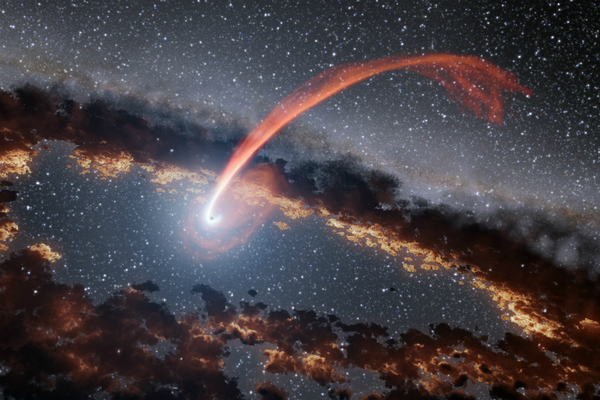By examining ‘echoes’ of infrared light, scientists were able to measure the intensity of black hole flare.
When objects approach a black hole, they become stretched under immense gravitational force – a phenomenon fittingly known as “spaghettification.” The black hole then devours its cosmic meal, before finally letting loose a massive, flaming cosmic belch.
For the first time, scientists have recorded this explosive event. By examining infrared light from black hole disruptions, which is captured and “echoed” by surrounding space dust, two separate research teams were able to measure the intensity of the flares. One study, which describes three such cases, was published last week in the Astrophysical Journal.
“The black hole has destroyed everything between itself and this dust shell,” lead author Sjoert van Velzen, a postdoctoral fellow at Johns Hopkins University, said in a statement. “It’s as though the black hole has cleaned its room by throwing flames.”
When a black hole consumes a star, it releases an incredible burst of energy. This phenomenon, called a “stellar tidal disruption,” produces bright flares surrounding the black hole’s event horizon. A handful of these events have been described in recent years, but those studies weren’t able to provide details beyond the mechanics of the “burp.”
Black hole flares are loaded with X-ray and ultraviolet radiation, which vaporize dust and other small pieces of matter. But particles can survive the radiation at a certain distance, leaving a shell of superheated dust a few trillion miles from the black hole’s center.
The surviving dust itself gives off infrared radiation, echoing the flare. This infrared emission can be detected for up to a year after the flare hits its brightness peak, say researchers.
Using data from NASA’s Wide-field Infrared Survey Explorer (WISE), researchers were able to capture these “light echoes.” By measuring the delay between the original flare and the infrared copy, they could determine the distance between the black hole and the dust. The WISE spacecraft performs scans every six months, so researchers were able to capture gradual changes in the emission.
The technique, called photo-reverberation, allows scientists to glean new information about stellar tidal disruptions and the location of dust circles around black holes.
“Our study confirms that the dust is there, and that we can use it to determine how much energy was generated in the destruction of the star,” co-author Varoujan Gorjian, an astronomer at NASA’s Jet Propulsion Laboratory, said in a statement.
Ning Jiang, an astrophysicist at the University of Science and Technology of China, led a second study which used light echoes to identify a fourth flare.
Source: The Christian Science Monitor

































Leave a Comment
You must be logged in to post a comment.